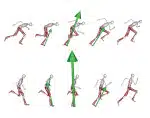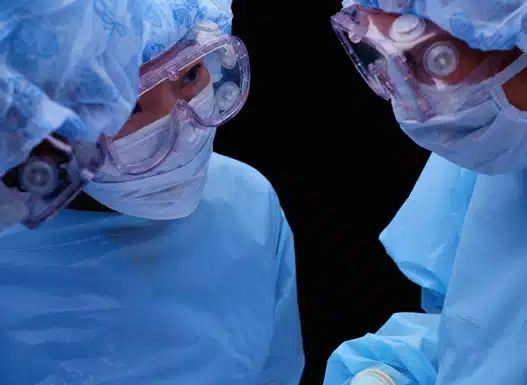
Computer simulations of a sprinter accelerating (top) and steady-state sprinting (bottom) to predict muscle-tendon force and energy
The term Achilles heel may be synonymous with weakness, but University of Melbourne researchers have found the Achilles tendon plays a more powerful role in movement than previously thought.
“Muscles propel the body, but they aren’t the whole story. Elastic-band-like tendons also store energy,” PhD student Adrian Lai says.
The team found that, across a range of movement speeds, the energy stored in the long Achilles tendon (which attaches to the calf) allowed the calf muscles to develop a large force efficiently.
Your body uses energy differently depending on the speed you are moving. When walking, the aim is to use the least amount of energy possible, whereas sprinting consumes much more energy so you get to your destination in the shortest period of time.
Yet, even though the goals of each locomotion are clearly defined, Adrian says we know surprisingly little about how muscles in the human legs power locomotion because it’s impossible to measure internal muscle forces without painful surgical procedures.
To see how muscles and tendons interact, Adrian and his colleagues combined the latest generation of real-time ultrasound techniques with computer modelling to predict muscle force and in particular, to separate how the muscle and tendon components behave.
“Previous studies have looked at individual muscles as a whole, but we were interested in understanding the interactions between the muscle fibres and the connected tendon, Adrian says.
Muscles contract to develop force, while the tendons store and release energy – transmitting it to the skeleton in order to move the body.
Adrian’s study found that the faster you run, the more the stored energy in the Achilles tendon contributes to moving the body, allowing the calf muscles to maintain ideal conditions for muscles to produce force.
“To run fast, we need to utilise elastic tendons such as the Achilles, which act like biological rubber bands – stretching and rapidly recoiling, propelling our body off the ground.”
“This interaction helps the muscles develop large forces in a short period of time, ensuring that sprinters achieve maximum speeds.”
The results provide valuable insight into the muscle-tendon arrangements in the lower leg for sport scientists and practitioners looking to improve the performance of athletes ahead of the 2016 Rio Olympics, and to speed up the rehabilitation time of injured athletes.
Adrian hopes the research will have a range of applications: “from designing training programs for athletes, to reducing injuries in the general population and driving the next generation of elastic-actuated robots.”
Adrian presented his research at Fresh Science Victoria 2015.
Fresh Science is a national program that helps early-career researchers find and share their stories of discovery. Over 30 early-career researchers nominated for Fresh Science Victoria, which was held at Scienceworks (training), Melbourne Museum (schools forum) and the Kelvin Club (public challenge event).
Fresh Science Victoria was supported by Museum Victoria, Bio-Medical Research Victoria and the Office of the Victorian Lead Scientist.
Adrian Lai, University of Melbourne, adriankmlai@gmail.com






 Fresh Science is on hold for 2022. We will be back in 2023.
Fresh Science is on hold for 2022. We will be back in 2023.